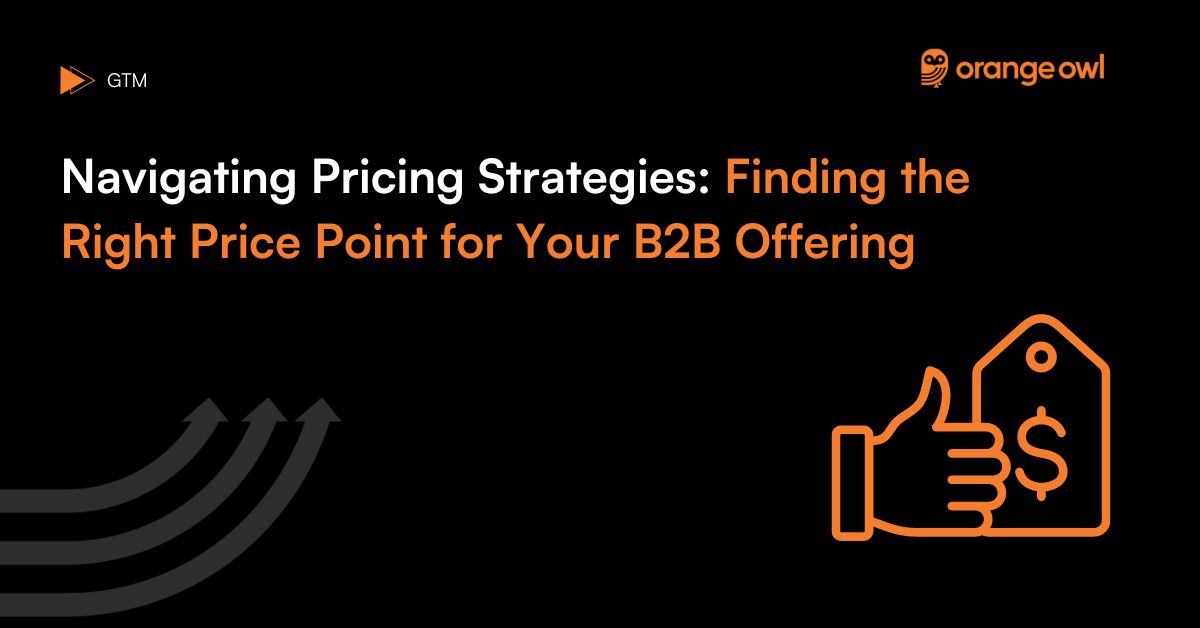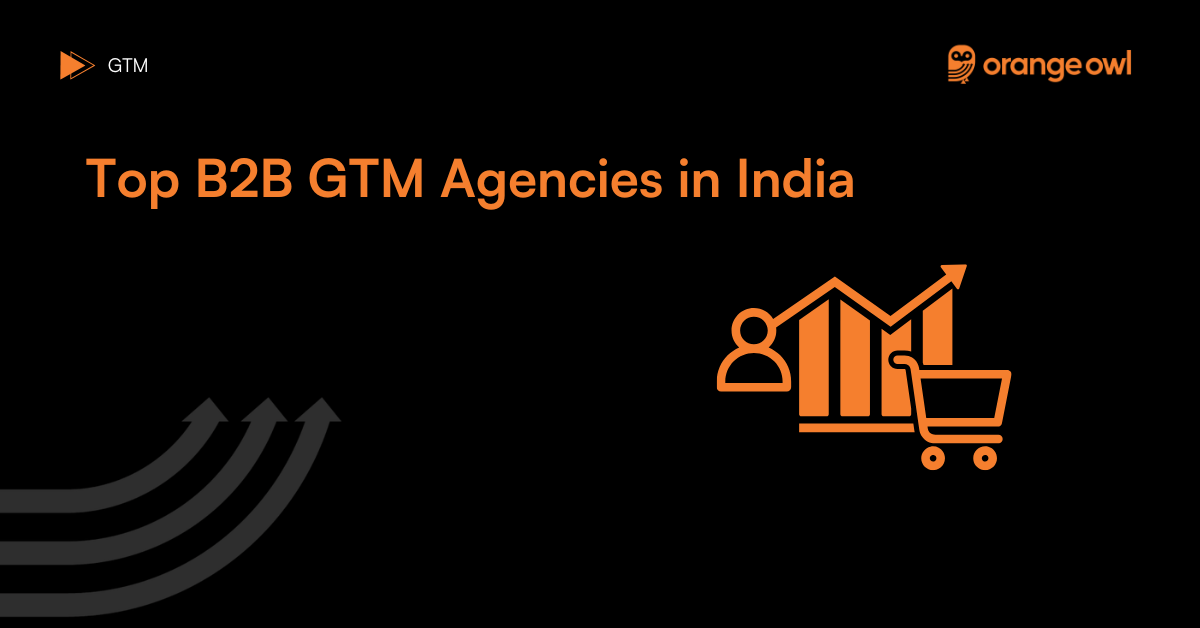Navigating Pricing Strategies: Finding the Right Price Point for Your B2B Offering
Orange Owl
June 16, 2025

Table of Contents
In the competitive B2B landscape, pricing strategy is a critical determinant of success. Finding the right price point for your B2B offering requires a careful balance between profitability, market demand, and perceived value. An effective pricing strategy not only ensures profitability but also aligns with your overall Go-to-market (GTM) strategy. This comprehensive approach integrates pricing with market positioning, target audience, sales tactics, and distribution channels, ensuring that your offering resonates with potential customers and stands out in a crowded market. This guide delves into effective pricing strategies and offers insights into setting the optimal price for your product or service, all within the context of a cohesive GTM strategy.

Understanding the Importance of Pricing in B2B
Pricing is more than just a number; it’s a reflection of your brand’s value proposition, market positioning, and competitive strategy. In B2B markets, pricing impacts not only revenue but also customer perception and market share. An optimal pricing strategy considers cost structures, customer value, competitor pricing, and market conditions.
Key Pricing Strategies for B2B
1. Cost-Plus Pricing
- Definition: Cost-plus pricing involves adding a standard markup to the total cost of producing a product to determine its selling price. This markup covers production costs and ensures a profit margin..
- Pros: Simple to calculate, ensures coverage of production costs.
- Cons: Ignores market demand and competitor pricing, potentially leaving money on the table.
- Example: A B2B example of cost-plus pricing can be found in manufacturing. Suppose a company like General Electric (GE) produces industrial equipment. They calculate the cost of raw materials, labor, and overhead for a piece of equipment at $50,000. By adding a 25% markup, they set the selling price at $62,500. This method ensures GE covers all production costs and achieves a profit.
2. Value-Based Pricing
- Definition: Value-based pricing sets prices based on the perceived value to the customer rather than on the cost of production. This strategy aligns prices with the benefits and value a product or service provides to the customer.
- Pros: Aligns price with customer willingness to pay, which can lead to higher margins.
- Cons: Requires deep understanding of customer needs and value perceptions, which can be complex and time-consuming to ascertain.
- Example: A good B2B example is Salesforce’s CRM software. Salesforce prices its CRM solutions based on the value it delivers in terms of improved sales management, customer insights, and business growth, rather than the cost of development. Enterprises are willing to pay a premium for the significant value Salesforce provides in streamlining operations and increasing sales efficiency.
3. Competitive Pricing
- Definition: Competitive pricing involves setting prices based on what competitors are charging for similar products or services. The goal is to remain competitive within the market.
- Pros: Easy to implement, ensures market competitiveness.
- Cons: This may lead to price wars, and could ignore unique value propositions.
- Example: In the B2B cloud storage market, companies like Amazon Web Services (AWS), Microsoft Azure, and Google Cloud Platform closely monitor each other’s pricing. If AWS reduces prices for its storage services, competitors often adjust their prices to remain competitive. This pricing strategy ensures they attract price-sensitive business customers looking for the best deal on cloud storage solutions.
4. Penetration Pricing
- Definition: Penetration pricing involves introducing a new product at a low price to gain market share quickly. The aim is to attract customers and establish a foothold in the market.
- Pros: Can rapidly attract customers and build market share.
- Cons: Low initial pricing can lead to lower profitability, and raising prices later can be challenging.
- Example: When Zoom Video Communications entered the video conferencing market, it offered its basic plan for free and its premium features at lower prices compared to established players like Cisco Webex. This penetration pricing strategy helped Zoom quickly gain market share and become a preferred choice for businesses during the rapid shift to remote work.
5. Skimming Pricing
- Definition: Skimming pricing involves setting high initial prices for a new product and then gradually lowering them over time. This strategy targets early adopters willing to pay a premium.
- Pros: Maximizes revenue from segments willing to pay more initially.
- Cons: May alienate price-sensitive customers early on.
- Example: When Tesla introduced its electric semi-truck, it set high initial prices targeting large logistics and freight companies willing to invest early in cutting-edge, sustainable transportation technology. Over time, as production scales and market acceptance grows, Tesla may lower prices to attract a broader range of customers.
6. Tiered Pricing
- Definition: Tiered pricing offers multiple price points for different levels of service or product features. This strategy caters to various customer segments with different needs and budgets.
- Pros: Appeals to different customer segments, and maximizes revenue across a broad range of customers.
- Cons: Can be complex to manage, and requires clear communication of value differences between tiers.
- Example: LinkedIn offers different tiers for its Sales Navigator product. The Professional, Team, and Enterprise plans each offer a range of features tailored to different sizes and types of businesses, from individual professionals to large sales teams. This tiered approach allows LinkedIn to serve a diverse customer base with varying needs and budgets.
7. Promotional Pricing
- Definition: Promotional pricing involves temporarily reducing prices to attract customers and boost sales. This strategy can be used to increase short-term sales, clear out inventory, or attract new customers.
- Pros: Can increase sales volume quickly, attract new customers, and clear out inventory.
- Cons: It may lead to lower profit margins and can train customers to wait for discounts.
- Example: HubSpot, a provider of marketing, sales, and service software, often runs promotions where they offer significant discounts on annual subscriptions during specific periods, such as at the end of the fiscal year. These promotions are aimed at attracting new customers who might be hesitant to commit at full price and boosting sales during slower periods.
Steps to Determine the Right Price Point
1. Understand Your Costs
- Begin by calculating the total cost of producing and delivering your product or service. This includes direct costs (materials, labor) and indirect costs (overhead, marketing).
2. Analyze the Market
- Conduct market research to understand the pricing landscape, including competitor pricing and customer expectations. Use tools like SWOT analysis to gauge market dynamics.
3. Gauge Customer Perceptions of Value
- Engage with customers to understand their perception of your product’s value. Surveys, focus groups, and customer interviews can provide insights into what customers are willing to pay.
4. Select a Pricing Strategy
- Based on your cost structure, market analysis, and customer value perceptions, choose the pricing strategy that aligns best with your business goals.
5. Set Your Price
- Establish your price point based on the chosen strategy. Ensure it covers your costs and aligns with the perceived value and competitive landscape.
6. Monitor and Adjust
- Continuously monitor the market, competitor actions, and customer feedback. Be ready to adjust your pricing strategy as needed to remain competitive and profitable.
Importance of Psychological Pricing in B2B
While psychological pricing is often associated with B2C markets, it also plays a significant role in B2B. Psychological pricing involves strategies that influence customer perception and buying behavior.
- Charm Pricing: Setting prices just below a round number (e.g., $99.99 instead of $100) can create a perception of a better deal.
- Price Anchoring: Presenting a higher-priced option first (the anchor) makes subsequent prices seem more reasonable.
- Bundle Pricing: Offering products or services as a package at a lower price than purchasing each item separately can enhance perceived value.
In B2B, these strategies can help make pricing more appealing and encourage purchasing decisions.
Leveraging Discounts and Promotions
Discounts and promotions can be powerful tools in your pricing strategy, especially for new customer acquisition and retention.
- Volume Discounts: Offering lower prices for larger purchases can incentivize bulk buying and increase overall sales.
- Seasonal Promotions: Time-limited offers can create urgency and drive sales during slower periods.
- Loyalty Programs: Rewarding repeat customers with discounts or special offers can enhance customer loyalty and lifetime value.
However, it’s crucial to balance discounts and promotions to avoid devaluing your product or creating a perception that the regular price is too high.
Implementing Dynamic Pricing
Dynamic pricing involves adjusting prices in real time based on market demand, competition, and other factors. This strategy is more common in industries like airlines and hospitality but is gaining traction in B2B.
- Benefits: Maximizes revenue by capitalizing on demand fluctuations, stays competitive, and optimizes pricing based on real-time data.
- Challenges: Requires sophisticated pricing algorithms and data analysis tools, and can lead to customer dissatisfaction if perceived as unfair.
Ethical Considerations in Pricing
Transparent and fair pricing practices are essential to maintain trust and credibility in B2B relationships. Ethical considerations include:
- Avoiding Price Gouging: Charging excessively high prices during times of high demand or scarcity can damage reputation.
- Honoring Agreements: Respecting contractual pricing terms and conditions helps build long-term customer relationships.
- Transparent Communication: Clearly communicating pricing structures, discounts, and any changes ensures customers understand and trust your pricing strategy.
Measuring the Success of Your Pricing Strategy
Evaluating the effectiveness of your pricing strategy involves tracking key performance indicators (KPIs) such as:
- Sales Volume: Monitor changes in sales volume to understand how price adjustments impact demand.
- Profit Margins: Ensure that pricing changes maintain or improve profitability.
- Customer Acquisition and Retention: Track new customer sign-ups and retention rates to gauge the impact of pricing on customer behavior.
- Market Share: Analyze changes in market share to see how pricing affects your competitive position.
Regularly reviewing these KPIs helps you make data-driven adjustments to your pricing strategy and ensures it aligns with your business goals.
Conclusion
Finding the right price point for your B2B offering is a complex but crucial task that requires a thorough understanding of your costs, market, and customer value perceptions. By employing a strategic approach to pricing, leveraging various pricing strategies, and continuously monitoring and adjusting based on market conditions and customer feedback, you can optimize your pricing to drive profitability and growth. Integrating this with a well-defined Go-to-market (GTM) strategy ensures that your pricing aligns with your market positioning, target audience, sales tactics, and distribution channels. Remember, the right pricing strategy not only maximizes revenue but also enhances customer satisfaction and loyalty, positioning your business for long-term success in the competitive B2B landscape.

FAQ’s
To determine the optimal price point, conduct thorough market research to understand customer preferences, competitor pricing, and industry trends. Consider factors such as production costs, value proposition, and target market demand. Experiment with different pricing models and analyze their impact on sales and profitability.
Factors to consider include your product’s uniqueness, market competition, customer segment preferences, cost structure, and overall business goals. Additionally, assess market demand elasticity, as well as the perceived value of your offering compared to alternatives.
The most suitable pricing model depends on your specific circumstances. Cost-plus ensures cost recovery but may overlook market dynamics. Value-based pricing aligns with customer perception but requires an understanding of complex value drivers. Competitive pricing helps maintain market share but may lead to price wars.
Focus on highlighting unique value propositions and tailored solutions that address specific pain points of your target audience. Offer bundled services or innovative pricing structures that set you apart while emphasizing quality, reliability, and superior customer service.
Market research provides insights into customer preferences, competitive landscape, pricing trends, and market dynamics. It helps identify pricing sensitivities, demand elasticity, and opportunities for differentiation, enabling informed decision-making in pricing strategy development.
Regularly monitor market trends, competitor actions, and customer feedback. Utilize flexible pricing structures that allow quick adjustments in response to market dynamics. Continuously analyze sales data and key performance indicators to evaluate the effectiveness of pricing strategies and adapt accordingly.
Ensure transparency and fairness in pricing practices to maintain trust and credibility with customers. Avoid price gouging during times of high demand and honor contractual agreements. Communicate pricing structures and any changes clearly to foster long-term relationships built on trust.
Track KPIs such as sales volume, profit margins, customer acquisition and retention rates, and market share. Analyze how pricing adjustments impact these metrics over time to assess the effectiveness of your pricing strategy and make data-driven decisions for optimization.


